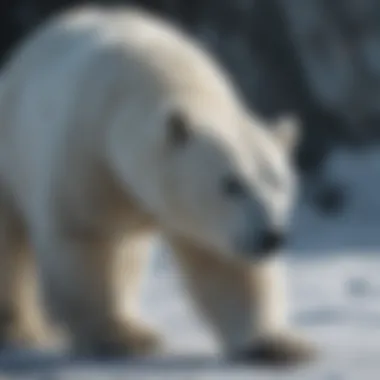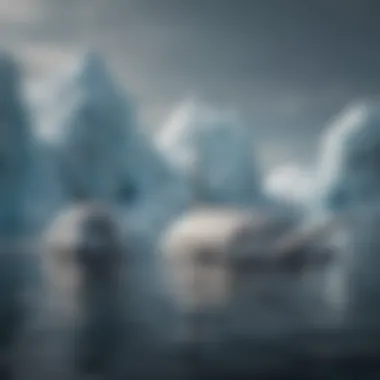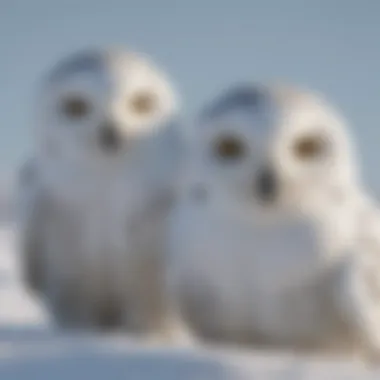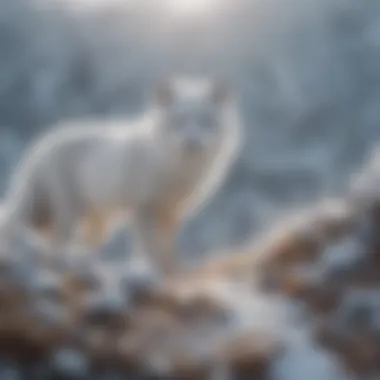Arctic Animals: Unique Adaptations and Conservation Insights


Intro
Nature Topic Overview
The Arctic is a place of extremes. It is known for its cold temperatures, ice-covered landscapes, and unique sunlight patterns. Yet, many animals thrive in this harsh environment. Understanding these creatures not only highlights their adaptations but also underscores the need for conservation. The Arctic employs a variety of wildlife, each adapted to the icy struggles of their surroundings. Through this exploration, young readers will discover the remarkable strategies these animals use to survive, revealing the intricate connections they have in their ecosystem. This exploration is crucial in showing how the impacts of climate change threaten their very existence.
Fun Facts and Trivia
Learning about Arctic animals can be exciting. Here are some fun facts:
- The Arctic fox has thick fur that changes colors in winter and summer.
- Polar bears utilize sea ice for hunting seals, which is their main food source.
- Narwhals, known for their long, spiral tusks, are sometimes called the unicorns of the sea.
Young learners can enrich their knowledge through visuals. Consider using interactive elements such as:
- Charts showing seasonal changes in animals.
- Maps depicting animal migration patterns.
- Videos of animals in their natural habitats for a more vivid understanding.
Wildlife Explorations
Let’s dive into specific Arctic species. Each animal has its distinct traits:
- Polar Bears: Adults can weigh up to 1,500 pounds. They primarily hunt seals and can swim for days.
- Arctic Wolves: These wolves work together in packs to hunt. They can travel long distances in search of food.
- Seals: Several species inhabit the Arctic waters, providing critical food for larger predators.
To enhance learning, consider including quizzes about animal remarks shared, or perhaps puzzles related to tracks in the snow. It makes the investigation more interactive and memorable.
Environmental Awareness
Conservation for Arctic animals is essential. These are important reasons:
- Climate Change: Global warming results in thawing ice, affecting nurseries for seals and polar bears.
- Pollution: Oil spills and waste from travel also impact these habitats.
- Over-hunting: Arctic species may suffer from excessive hunting pressure.
Kids can help in these ways:
- Raise awareness about recycling and reducing plastic use.
- Participate in local conservation projects.
- Educate peers and family about Arctic wildlife through discussions.
DIY Nature Activities
Putting knowledge into action can be fun. Here are some activities:
- Snow Painting: Using food coloring and water, create colorful designs outside in the snow.
- Animal Tracking: When outside, look for footprints and try to identify the animals that made them.
- Craft a Sled: Build a small sled using cardboard to mimic transportation used by Arctic animals.Following step-by-step guides makes it simple:
- Measure and cut cardboard into suitable shapes.
- Connect pieces to resemble a sled.
Thus, applying what has been learned about Arctic animals can further ignite curiosity. Participation in these activities fosters their understanding of wildlife and safety.
Conservation is not merely an act; it is a collective responsibility. The Arctic's treasures are precious. Like breathing ice organisms, they are here today but must be watched over carefully.
Prelims to Arctic Habitats
Understanding Arctic habitats is essential to explore at the beginning of our journey into the lives of Arctic animals. This section will help us set the stage for their vibrant world. The Arctic is more than just a barren land; it is teeming with life adapted to its unique conditions. Knowing these habitats will make the study of Arctic animals richer and truly captivating.
Definition of the Arctic Region
The Arctic region refers to the area around the North Pole, characterized by extreme cold, ice, and unique ecosystems. Countries that include parts of the Arctic are Norway, Canada, Russia, and Greenland. It spreads over various territories and has features like tundra, sea ice, and polar deserts. The land is often frozen, making plants and animals here specially engineered to survive. In this frozen world, life exists in unexpected places, getting shaped primarily by the brutal environment.
Climate and Weather Patterns


The climate in the Arctic is notorious for being harsh and extreme. Winters are long and brutally cold with temperatures often plummeting below -30°C. Summers, on the other hand, are cool and short. This area experiences phenomena like permafrost and polar nights. Snow covers the region in winter, while the summer sees a soft shroud of greenery peeking through as the ice and snow melt.
Here are two main characteristics of Arctic weather patterns:
- Long periods of darkness: During winter, regions of the Arctic undergo continuous darkness for several months. Even in winter, some areas experience continuous daylight.
- Brief warm seasons: Summer brings warmth, having temperatures that can get to around just above freezing, allowing some form of life to thrive.
In summary, the unique climate conditions of the Arctic make it a distinctive realm that challenges the organisms living within it. From an environmental point of view, winter serves not only as a test for survival but shapes many relationships between species, be it predator and prey or symbiotic partners.
Understanding the landscape and climate of the Arctic enhances our awareness of how adaptable and resilient life can be.
Types of Arctic Animals
Understanding the types of Arctic animals allows us to see how species adapt to one of the Earth's toughest environments. This section explores different categories of Arctic wildlife, highlighting their significance in ecosystem balance and broader biodiversity. Each group of animals—mammals, birds, and fish—plays specific roles within their habitat. Learning about these types emphasizes not only their individuality but also their interconnectedness in maintaining ecological stability.
Mammals of the Arctic
Arctic mammals have developed unique adaptations to thrive in extreme cold. For instance, the polar bear is a remarkable symbol of resilience with its thick blubber and fur. Its white coloration provides insulation and camouflage against the icy landscape. Besides polar bears, other mammals such as reindeer, seals, and Arctic foxes have interesting adaptations for surviving harsh conditions.
Reindeer, known as caribou in North America, migrate long distances to find food. They have special hoof structures aiding in travel across snow and ice. Seals have a layer of fat called blubber, which retains body heat and offers buoyancy in icy waters. The Arctic fox has a compact body shape to conserve warmth and can change the color of its fur depending on the season.
Challenges these mammals face include habitat losses due to climate change affecting ice platforms and their food sources. For instance, the decline in seal populations influences the polar bear's ability to hunt and survive.
Bird Species Found in the Arctic
The Arctic is home to a variety of bird species, many of which migrate thousands of kilometers to breed in its short summer months. Notable species include the puffin, snowy owl, and Arctic tern. Each of these birds exhibits adaptations suited for the short, resource-rich summer, and distinct lifestyles
The puffin, recognized for its colorful beak, is an excellent diver, catching fish underwater. Snowy owls fare well in snowy landscapes thanks to their white feathers that provide camouflage. They hunt small mammals such as lemmings, and their thick feathers offer insulation from cold.
Arctic terns engage in long migrations between the Arctic and Antarctic regions, which is the longest migratory journey of any bird. Through migration, these birds play a crucial role in nutrient cycling and ecosystem dynamics.
Fish and Marine Life
The Arctic Ocean supports a diverse range of fish and other marine creatures. Species such as Arctic cod, salmon, and various crustaceans are vital parts of the marine ecosystem. Together, they form an essential food web that connects various stakeholders.
Arctic cod, for example, is a foundational species for many larger predators, including seals and seabirds. This fish has unique adaptations, like antifreeze proteins in their blood, which allow them to thrive in freezing waters.
Moreover, marine mammals like whales and narwhals depend on fish and other oceanic life. The interconnectedness highlights the delicate balance in marine habitats. Declining fish populations due to climate factors pose significant threats, linking climate change impact on manatees higher up in the food chain.
Disturbingly, pollution and overfishing cause additional stress to these species, further complicating their ability to thrive. Conservation needs appear urgent for fish and marine life.
Understanding diverse Arctic wildlife enhances awareness about preservation challenges and inspires education on environmental responsibilities.
Adaptations of Arctic Animals
Understanding the adaptations of Arctic animals is crucial to grasp how these creatures thrive in one of the most inhospitable regions on Earth. Their remarkable traits help them survive extreme cold, long periods of darkness, and scarce food sources. Each adaptation plays a pivotal role in sustaining not only the species itself but the broader ecological balance in these unique habitats. As we delve into physical and behavioral adaptations, we unearth the complexities of life under the polar conditions.
Physical Adaptations
Physical adaptations are traits that enhance the ability of Arctic animals to survive their unique environment. These adaptations help them cope with the cold weather and the challenging landscape. Here are some notable examples:
- Insulated Bodies: Animals like the polar bear possess thick layers of fat and fur that provide warmth. The fat layer can be up to four inches thick, protecting them from icy waters and freezing temperatures.
- Camouflage: Many Arctic animals, such as the Arctic fox or the snowshoe hare, have white fur in winter that blends into the snow, helping them evade predators. In summer, they often change to a brown coat, contrasting with the tundra background.
- Size and Shape: Bergmann's Rule explains that larger animals in colder climates tend to have a smaller surface area relative to their volume, minimizing heat loss. Thus, moose and musk oxen have adapted to have substantial body mass in the Arctic.
Each of these adaptations serves to bolster individual survival in a cold ecosystem full of challenges.
Behavioral Adaptations
Behavioral adaptations encompass the actions taken by animals to survive and reproduce in the harsh Arctic climate. Understanding these actions helps illustrate how life perseveres in adverse environments.


- Migration: Certain bird species, such as the Arctic tern, undertake long migrations to warmer areas for breeding. They benefit by avoiding the extended Arctic winter, allowing them to return when food is more abundant.
- Huddling: Many animals, like penguins, employ huddling behavior to retain heat. By staying close together in tight groups, they reduce individual heat loss and provide protection against chilling winds.
- Seasonal Activity: Different species alter their activity levels based on the seasonal availability of food. For example, some bears hibernate in the winter, relying on fat reserves, while other animals might only forage during specific hours when temperatures are slightly warmer.
“Adaptations are not just physical features, but also crucial behaviors that help wildlife cope with the Arctic's extreme conditions.”
Understanding both physical and behavioral adaptations provides deeper insights into the survival mechanisms of these Arctic animals. These features underscore the intricate relationship between Arctic species and their environment, displaying nature's remarkable ability to adapt to extreme circumstances.
Predators and Prey
Understanding the dynamics between predators and prey in the Arctic is vital for comprehending how this unique ecosystem functions. Each species plays a role in maintaining ecological balance. The interdependence of these animals creates a complex web of life. Predator and prey relationships influence population dynamics, which in turn affect habitat health and biodiversity. As Arctic habitats change due to climate conditions, these interactions might alter significantly, impacting both groups.
Top Predators of the Arctic
The Arctic is home to several apex predators that regulate the populations of their prey. These organisms have evolved several adaptations to thrive in such a harsh environment.
- Polar Bears - Known for their remarkable insulation and sharp hunting skills, polar bears are at the top of the food chain. They rely heavily on seals for nutrition. When hunting, they use a method called "still hunting", where they patiently stalk their prey until the perfect moment to strike.
- Arctic Foxes - These adaptable foxes can survive in extreme conditions. They often scavenge from polar bears and hunt small mammals, birds, and the eggs they can find. Their thick coats provide warmth, and their keen sense of smell helps detect food hidden under the snow.
- Walruses - Not only do walruses hunt for clams and other mollusks, but they also face threats from human activities and sea ice changes. Their large tusks also play a role in fighting off intruders which are essential for their survival.
Consider the hunting strategies these predators use and how it affects availability and competition for resources with other species.
Common Prey Species
The prey species in the Arctic are crucial for the survival of predators. These animals have developed their own set of adaptations to withstand predators while thriving in their environment.
- Seals - Different species like the ringed seal and bearded seal live in the Arctic waters. They have camouflaged fur and aren’t easily spotted by polar bears. Seals are a primary food source.
- Lemmings - These small rodents are significant for predator diets. They reproduce in large numbers, providing ample food for Arctic foxes and owls during the summer months. Managing their populations is crucial for maintaining balance in the food chain.
- Fish - Species such as Arctic cod provide essential nutrition for many predators. They are abundant in Arctic waters and adapt well to different temperature conditions.
The relationships between predators and prey showcase the delicate balance of Arctic ecosystems. Changes in one group can have cascading effects on the others, affecting both their survival and their habitats.
Impact of Climate Change on Arctic Animals
The topic of climate change's effect on Arctic animals is highly relevant in today's discussions about environmental science and conservation. As the Arctic region undergoes significant transformations, understanding these impacts is crucial for fostering awareness and encouraging preservation efforts. The Arctic serves as an indicator for global climate change, revealing changes that can affect wildlife, ecosystems, and communities. Highlighting these effects can help the readership connect deeper with nature and underscores the necessity of taking action.
Threats to Habitat and Survival
The habitats in the Arctic are facing numerous threats due to climate change. One major concern is the melting of sea ice, which acts as a critical habitat for many species.
- Shrinking Habitats: The extent of sea ice is dwindling. This affects species like polar bears and seals that rely on this ice for hunting and breeding.
- Loss of Food Sources: Warming waters can alter food webs dramatically. Fish populations may decline or migrate, disrupting the ecosystems that Arctic animals depend on.
- Increased Human Activity: Opportunities for fishing, oil drilling, and shipping in ice-free waters are rising. This brings competition and potential oil spills that can threaten wildlife.
Research indicates that up to 50% of certain Arctic habitats may disappear within the next few decades without intervention.
The cumulative effect of these shifts poses significant risks to wildlife survival. As habitats degrade, many species face peril, struggling to adapt or find alternatives for sustenance.
Response of Species to Changing Environments
Animals in the Arctic are not passive in the face of climate changes. They exhibit various responses, showcasing resilience but also highlighting their struggles.
- Migration Patterns: Some species are shifting their migration routes as they follow the changes in food availability resulting from the warming ocean currents.
- Changing Breeding Habits: Certain bird species may be altering their breeding seasons in response to warmer temperatures. They may breed earlier if sea ice melts sooner.
- Physiological Adaptations: Animals may also develop new traits over generations, like thicker fur or altered hunting strategies. Such adaptations are vital for their survival but can take long time to evolve.
Conservation Efforts
Conservation efforts are critical for protecting the animals that thrive in Arctic regions. As climates shift and habitats become threatened, it becomes increasingly essential to engage in strategies that preserve both the wildlife and the ecosystems they are part of. These efforts not only help species survive but also contribute to maintaining the delicate balance of the Arctic's ecosystem.
Various organizations and community groups focus on these significant tasks. Conservation efforts can lead to several important benefits:
- Preservation of endangered species.
- Protection of fragile habitats against disturbances.
- Restoration of ecosystems that have been impacted by climate change.
- Promotion of awareness about the importance of Arctic animals to broader ecological health.
In essence, conservation acts as a lifeline for Arctic biodiversity.


Organizations Focused on Arctic Wildlife
Many prominent organizations target their efforts on the conservation of Arctic animals. These groups engage in research, education, and advocacy.
Some notable organizations include:
- World Wildlife Fund (WWF): Focuses on keeping populations of vulnerable Arctic animals like polar bears sustainable.
- Greenpeace: Engages in activism to alter policies affecting wildlife habitats, predominantly due to climate change and pollution.
- Local Conservation Groups: These community-based organizations often play a direct role in protecting specific species and their habitats within local territories.
These organizations rely on collaborations with scientists, indigenous communities, and other stakeholders to enhance their conservation initiatives.
Community Involvement in Conservation
Community involvement is key in conservation. Local communities often hold a wealth of traditional knowledge about their environment and wildlife. Additionally, involving residents in conservation efforts fosters a sense of ownership over local habitats and animals.
Communities can participate in conservation from many angles:
- Participating in local wildlife surveys.
- Educating younger generations about the importance of preserving their native ecosystems.
- Supporting local policies that promote proper environmental stewardship.
By understanding and participating in conservation efforts, communities become more than just observers; they become active guardians of their environment.
Significance of Arctic Wildlife
The Arctic wildlife carries immense chiarcteristics that contribute not only to the ecosystem but also to the global environmental balance. Understanding their significance helps us appreciate the complex interactions that sustain life in this harsh climate. The richness of biological diversity in the Arctic showcases the aptitude of animals thriving under extreme conditions. Their existence represents crucial components in ecological networks, which in turn conserves planetary health.
Ecological Importance
Arctic animals play vital roles in their habitats. They all contribute in versatile ways to maintain a balanced ecosystem. This includes predatory relationships and various food chains.
- Species Interdependence: Arctic species are interlinked. Without the Arctic foxes and polar bears as apex predators, the populations of prey such as lemmings would rapidly increase, disrupting local flora and manpower resources.
- Nutrient Cycling: Animals like seals and birds aid in transferring nutrients between land and ocean. When they feed, and wehn they excrete, they recycle nutrients into the ground, promoting the health continuities of tundra and marine systems.
Encouraging interest in these ecological components endangers not only existing mammals, but wildlife communities visible from polar bears to arctic seals. Therefore, this brings awareness to their ecological significances.
Cultural Relevance to Indigenous Peoples
The indigenous peoples of the Arctic, such as the Inuit, have strong ties to the land and its wildlife. These communities rely on the animals for sustenance, shelter, and cultural identity.
- Traditional Practices: Hunting and fishing are not just activities but integral parts of life. Elders pass on knowledge about seasonal migrations and sustainable practices which support thriving ecosystems.
- Cultural Symbolism: Species like the polar bear and narwhal go beyond practicality; they embody spiritual significance and mythology. They serve as cultural symbols that represent adaptation and resilience.
“Arctic wildlife is woven into the culture and practices of indigenous peoples, enriching not just their diet, but also their lifestyle and heritage.”
Awareness about the significance of arctic wildlife fosters appreciation and respect for the traditional knowledge intertwining wildlife and indigenous communities. It emphasizes the need for communal efforts in conserving these phenomenal species amidst climate change. Educating young minds about this intricate connection is vital for preserving rich cultures and ecological uniqueness.
Closure
The conclusion of this article serves to highlight the compelling significance of Arctic animals and underline their intricate relationships within their habitats. Summarizing the essential points discussed throughout the text allows readers to reflect on the unique adaptations and ecological roles of these species. It showcases the stark challenges they face due to climate change and emphasizes the urgent need for concerted conservation efforts.
Summary of Key Points
In our exploration of Arctic wildlife, we aimed to provide an informative view of diverse animal species and their habitats. Key insights include:
- Diversity of Species: The Arctic is home to distinct mammals, birds, and marine life, each with special traits that help them withstand the extreme environment.
- Adaptations: Unique physical and behavioral adaptations enable Arctic animals to thrive despite harsh temperatures and scarce food resources.
- Ecological Roles: Each species, from polar bears to Arctic foxes, plays a significant role within their ecosystem, maintaining a balance that impacts other species and habitats.
- Climate Change Impact: The alarming effects of climate change are threatening Arctic habitats and consequently the species that depend on them.
- Conservation Importance: Understanding the ecological significance and communal cultural ties facilitates the conservation of these unique species.
Future Outlook for Arctic Animals
Looking ahead, several factors will influence the fate of Arctic animals. Continued monitoring of their populations, along with innovative conservation strategies, is critical.
- Effects of Climate Change: Scientists will continue to observe how rising temperatures and melting ice impact animal behavior and breeding success. Strategies must adapt swiftly to keep pace with these developments.
- Community Involvement: Empowering local communities can have a positive impact on conservation practices. Educating and engageing indigenous populations is vital, as they hold traditional knowledge that contributes to sustainable coexistence.
- Global Cooperation: International collaboration is essential to implement effective policies aimed at protecting Arctic habitats. Governments, joint initiatives, and organizations must working together to share resources and knowledge.
The future of Arctic animals is at a crossroads. By understanding their roles and the impacts they face, collective action can help ensure their survival for generations to come. Only through awareness and proactive conservation can we preserve this vital ecosystem and the remarkable creatures within it.
"Conserving our Arctic wildlife is not just an ethical responsibility; it is crucial for maintaining the balance of Earth's ecosystems."
For more comprehensive details about Arctic animals, you can visit relevant sources such as Wikipedia and Britannica.







